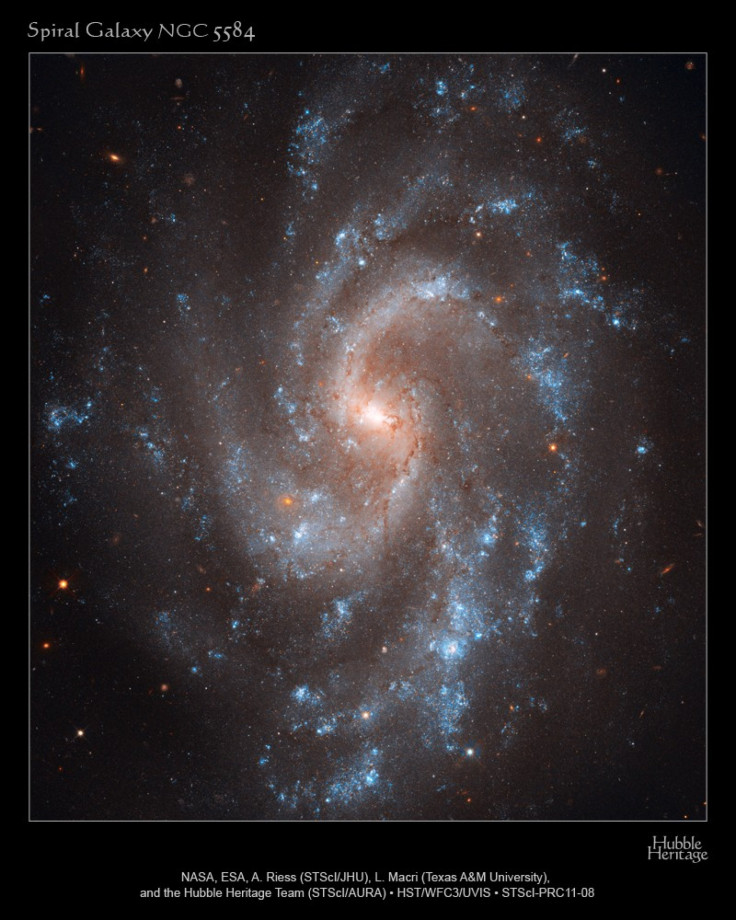Researchers Rule Out Alternate Dark Energy Theory

Researchers have ruled out an alternate theory on the nature of dark energy after recalculating the expansion rate of the universe with the help of NASA's Hubble Space Telescope.
The universe appears to be expanding at an increasing rate and some believe that is because the universe is filled with a dark energy that works in the opposite way of gravity.
One alternative to that theory is that an enormous bubble of relatively empty space eight billion light-years across surrounds our galactic neighborhood. If we lived near the center of this void, observations of galaxies being pushed away from each other at accelerating speeds would be an illusion.
However, this theory has been invalidated because astronomers have refined their understanding of the universe's present expansion rate. Adam Riess of the Space Telescope Science Institute (STScI) and Johns Hopkins University in Baltimore, Md., led the new research.
The new observations with Hubble telescope helped determine a figure for the universe's current expansion rate to an uncertainty of just 3.3 percent and cut the error margin by 30 percent over Hubble's previous best measurement of 2009.
Since astronomers cannot physically measure the distances to galaxies, researchers had to find stars or other objects that serve as reliable cosmic yardsticks.
Riess' team used stars as cosmic yardsticks to measure the universe's expansion rate and they first had to determine accurate distances to galaxies near and far from Earth.
The team compared those distances with the speed at which the galaxies are apparently receding because of the expansion of space. They used those two values to calculate the Hubble constant, the number that relates the speed at which a galaxy appears to recede to its distance from the Milky Way.
The value for the expansion rate is 73.8 kilometers per second per megaparsec. It means that for every additional million parsecs (3.26 million light-years) a galaxy is from Earth, the galaxy appears to be traveling 73.8 kilometers per second faster away from us.
Knowing the precise value of the universe's expansion rate further restricts the range of dark energy's strength and helps astronomers tighten up their estimates of other cosmic properties, including the universe's shape and its roster of neutrinos, or ghostly particles that filled the early universe.
In physical cosmology, astronomy and celestial mechanics, dark energy is a hypothetical form of energy that permeates all of space and tends to increase the rate of expansion of the universe.
Dark energy, which is one of the greatest cosmological mysteries in modern physics, is the most accepted theory to explain recent observations and experiments that the universe appears to be expanding at an accelerating rate. In the standard model of cosmology, dark energy currently accounts for 73 percent of the total mass-energy of the universe
The idea of dark energy was so far-fetched that many scientists began contemplating other strange interpretations, including the cosmic bubble theory. In this theory, the lower-density bubble would expand faster than the more massive universe around it.
To an observer inside the bubble, it would appear that a dark-energy-like force was pushing the entire universe apart. The bubble hypothesis requires that the universe's expansion rate be much slower than astronomers have calculated, about 60 to 65 kilometers per second per megaparsec. By reducing the uncertainty of the Hubble constant's value to 3.3 percent, Riess reports that his team has eliminated beyond all reasonable doubt the possibility of that lower number.
The hardest part of the bubble theory to accept was that it required us to live very near the center of such an empty region of space, explained Lucas Macri, of Texas A&M University in College Station, a key collaborator of Riess. This has about a one in a million chance of occurring. But since we know that something weird is making the universe accelerate, it's better to let the data be our guide.
The astronomer hopes that Hubble will continue to be used in this way to reduce the uncertainty in the Hubble constant even more, and thus refine the measured properties of dark energy. He suggests the present uncertainty could be cut in two before Hubble gives way to improvements out of Hubble's reach but within the scope of the James Webb Space Telescope, an infrared observatory scheduled to launch later this decade.
© Copyright IBTimes 2024. All rights reserved.











